Limited resources of natural quartz crystal suitable for direct electronic or optical use are available throughout the world. World dependence on these resources will continue to decline because of the increased acceptance of cultured quartz crystal as an alternative material; however, use of cultured quartz crystal will mean an increased dependence on lascas for growing cultured quartz.
Trends indicate that demand for quartz crystal devices should continue to grow, and consequently, quartz crystal production should remain strong well into the future. Growth of the consumer electronics market (for products such as personal computers, electronic games, and cellular telephones) will continue to drive global production. The growing global electronics market may require additional production capacity worldwide.
In the past several years, cultured quartz crystal was increasingly produced in the world, primarily in Asia. Electronic applications accounted for most industrial uses of quartz crystal; other uses included special optical applications.Virtually all quartz crystal used for electronics was cultured rather than natural crystal. Electronic-grade quartz crystal was essential for making filters, frequency controls, and timers in electronic circuits employed for a wide range of products, such as communications equipment, computers, and many consumer goods, such as electronic games and television receivers.
Quartz crystal is the best material for frequency-control oscillators and frequency filters in electronic circuits.
Kingtronics offers leaded quartz crystal HC49U, HC49S and SMD quartz crystal HC49SMD.If you want more details ,please visit website www.kingtronics.com for full specification.
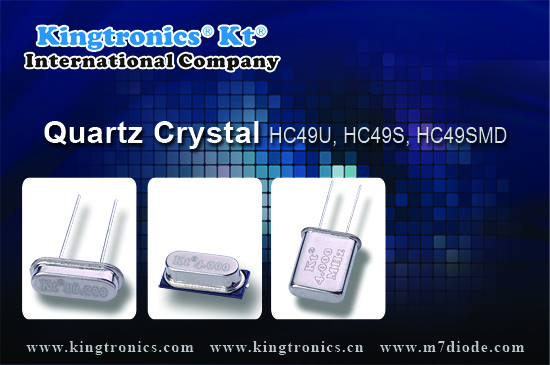
Kingtronics Quartz Crystal
28 Feb 2011Electronic-grade quartz crystal is single-crystal silica that is free from all visible defects and has piezoelectric properties that permit its use in electronic circuits for accurate frequency control, timing, and filtration. These uses generate practically all the demand for electronic-grade quartz crystal. A smaller amount of optical-grade quartz crystal is used as windows and lenses in specialized devices including some lasers.
More natural quartz crystal was consumed in electronic and optical applications until 1971, when cultured quartz crystal took the lead. Since that time cultured (synthetic) quartz has replaced natural crystal in practically all these applications. The use of natural quartz crystals for carvings and other gemstone applications continued; quartz crystals for this application are discussed in the Gemstones Annual Report of the U.S. Bureau of Mines.
- 0Commentary
- Tags:
A quartz crystal resonator depends on the piezo-electric effect to work. This effect converts a mechanical stress in a crystal to a voltage and vice versa. In this way the piezo-electric effect converts the electrical impulses to mechanical stress which is subject to the very high Q mechanical resonances of the crystal, and this is in turn linked back into the electrical circuit.
The quartz crystal can vibrate in several different ways, and this means that it has several resonances, all on different frequencies. Fortunately the way in which the quartz crystal blank is cut from the original crystal itself can very significantly reduce this. In fact the angle of the faces relative to the original crystal axes determines many of its properties from the way it vibrates to its activity, Q, and its temperature co-efficient. There are three main ways in which a crystal can vibrate: longitudinal mode, low frequency face shear mode, and high frequency shear. A cut known as the AT cut used for most crystals used in traditional radio and electronics circuits uses the high frequency shear mode.
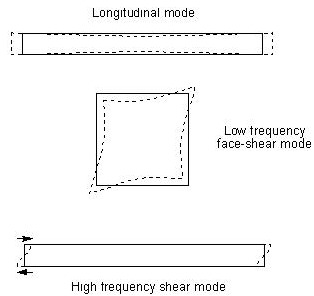
Vibrational modes of a quartz crystal resonator
(For the sake of clarity, the movements have been greatly exaggerated)
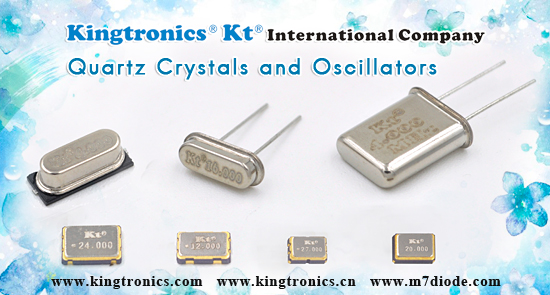
The equivalent series resistance is the resistive element (R1) of the quartz crystal equivalent circuit. (see Equivalent Circuit below) This resistance represents the equivalent impedance of the crystal at natural resonant frequency (series resonance) ESR is measured by a Crystal Impedance (CI) meter.
ESR values are generally stated as maximum values expressed in ohms. The ESR values vary with frequency, mode of operation, holder type, crystal plate size, electrode size, and mounting structure.
It is worth noting that the ESR value at a given frequency for an AT- strip crystal design is generally higher than that of the standard (round blank) design. This becomes more significant at lower frequencies. When transitioning from a series resonant through-hole HC-49/U type crystal to a smaller surface mount type utilizing an AT-strip crystal, some consideration may be given to the difference in the ESR values produced by different cuts.
The ESR becomes critical when resistance values reach a point were the oscillator circuit cannot adequately drive the crystal. Sluggish start-up or unwanted modes of operation may result.
Equivalent Circuit:
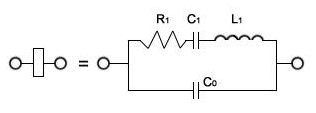
The equivalent circuit (shown in Figure A) depicts electrical activity of a quartz crystal unit operating at its natural resonant frequency. The shunt capacitance (Co), represents the capacitance of the crystal electrodes plus the capacitance of the holder and leads. R1, C1, and L1 compose the "motional arm" of the crystal, and are referred to as the motional parameters. The motional inductance (L1) represents the vibrating mass of the crystal unit. The motional capacitance (C1) represents the elasticity of the quartz, and the resistance (R1), represents bulk losses occurring within the quartz.
- 0Commentary
- Tags:
Kingtronics Quartz crystal ageing
29 Jan 2011Quartz crystals used in filters and oscillators in electronic circuits are renowned for their performance, stability, frequency tolerance and their high Q. Yet they do change their frequency very slightly with time in a process known as ageing. Although the frequency variations are small by many standards, they are permanent and may have an effect in some applications where the frequency is of great importance. As a result manufacturing techniques take account of this to reduce the effects of ageing in these crystals as far as possible.
Ageing is caused by a number of interrelated factors. These include internal contamination, excessive drive level, surface change of the crystal, various thermal effects, wire fatigue and frictional wear. The level of ageing can be minimised in a number of ways. During manufacture they should be encapsulated in an inert gas environment, the ensuring should have a good seal so that other gases do not enter. Also the final stages of the preparation of the crystal blank must be prepared as finely as possible. Rather than lapping the blank to bring it to the right dimensions, chemical etching is used. In this way the minimum disruption is caused to the crystal lattice, and this reduces the ingress of contaminants over time that will cause ageing.
The design of the circuit in which the crystal will be used also has an effect. By keeping the drive levels low again the crystal ageing will be less.
- 0Commentary
- Tags:
The frequency of the quartz crystal is obviously a fundamental specification. It is normally expressed to as many significant figures as demanded by the frequency tolerance, although seven figures is normally the maximum. It is wise to express the frequency to the right number of significant figures to avoid misunderstandings in this area of the quartz crystal specification.
Kingtronica Quartz Crystal series are popular in the word market , Quartz Crystal include HC49U, HC49S and SMD quartz crystal HC49SMD .The HC49U is available in tight tolerances and stabilities for demanding applications. With a broad frequency range from 1.8432MHz to 200.000MHz, the HC49U can serve as a low cost solution in virtually any application or market.

- 0Commentary
- Tags:
Quartz Crystal HC49S Temperature stability
13 Jan 2011The temperature stability is another important area of the crystal specification and it is the allowable frequency deviation as the temperature varies. Again normally expressed in ppm, from the frequency at the reference temperature per degree Celsius. Sometimes the crystal specification may use a frequency tolerance consisting of the sum of the calibration and temperature stability tolerances is quoted.
Over the Operating Temperature Range, an amount of total deviation acceptable for the application. Tighter specifications of Stability lower yield in Quartz Crystal Blank production thereby serving to increase production costs
Kingtronics offers high quality quartz crystal at incredibly aggressive prices. The HC49S series is an industry standard crystal package. HC49S is a low cost, low profile timing option for applications where cost is critical.
The HC49S is available in tight tolerances and stabilities for demanding applications. With a broad frequency range from 3.200MHz to 90.000 MHz, the HC49S can serve as a low cost solution in virtually any application or market.
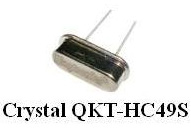
- 0Commentary
- Tags:
Kt Kingtronics What is Quartz Used for?
5 Jan 2011Quartz is used in the making of sandpaper, optics, glass, liquid filters, circuit boards, computer components, cement, mortar, and jewelry. Quartz crystals are also piezoelectric meaning when an electrical current passes through them they vibrate a small amount. Time can be measured from the vibrations of the quartz crystals so quartz crystals are often used in clocks.
Quartz crystals may either operate in a fundamental mode or in an overtone mode. Below frequencies of around 25 MHz crystals are normally designed to operate in their fundamental mode, whereas above this they will normally be designed for overtone operation, although with manufacturing techniques improving higher frequency crystals are becoming available. The mode is therefore an important element of the crystal specification.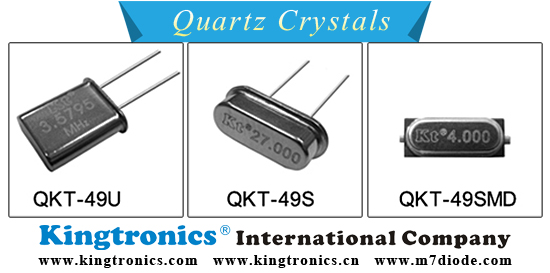
Kt Kingtronics Crystal Oscillators
17 Dec 2010Crystal oscillators are used in a variety of applications. In some instances crystal oscillators may be used to provide a cheap clock signal for use in a digital or logic circuit. In other instances they may used to provide an RF signal source. In view of the fact that quartz crystals offer a very high level of Q and they are stable, crystal oscillators are often used in oscillator circuits to provide stable, accurate radio frequency signals.
There is a great number of different types of circuit that can be used for crystal oscillators, each one having its own advantages and disadvantages. One of the most common circuits used for crystal oscillators is the Colpitts configuration as shown below.

In this configuration, the crystal operates in a parallel mode. When running in this mode, the crystal should be presented with a load capacitance to operate on its correct frequency. This load capacitance is specified with the crystal and is typically 20 or 30 pF. The crystal oscillator circuit will be designed to present this capacitance to the crystal. Most of this will be made up by the two capacitors C1 and C2, although the remaining elements of the circuit will provide some capacitance.
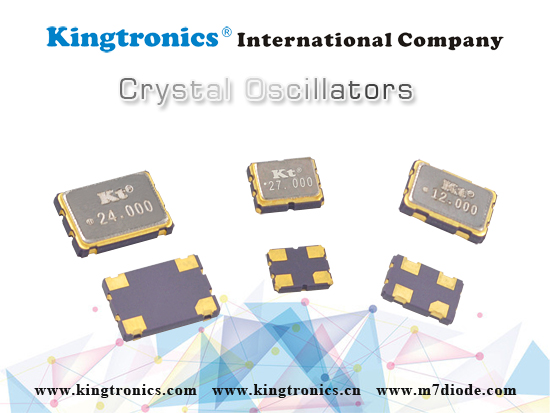
Quartz crystal overview
6 Dec 2010Quartz crystals use the piezoelectric effect to convert the incoming electrical impulses into mechanical vibrations. These vibrations are affected by the mechanical resonances of the crystal, and as the piezoelectric effect operates in both directions, the mechanical resonances affect the electrical stimuli, being reflected back into the electrical circuit.
Today, quartz crystal filters can be designed with pass bands ranging from frequencies in the kilohertz region up to many Megahertz - with the latest technology this can rise to 100 MHz and more. However for the best performance and lowest costs the passband of the filter is generally kept to below about 30 MHz or so.
- 0Commentary
- Tags:
Contact us
Tel: (86) 769 8118 8110
Tel: (852) 8106 7033
Fax: (852) 8106 7099
E-mail: info@kingtronics.com
Skype: kingtronics.sales
Web: www.Kingtronics.com
YouTube: www.youtube.com/c/Kingtronicskt
About
Kingtronics International Company was established in 1995 located in Dongguan City of China to handle all sales & marketing for factories located in Chengdu, Sichuan and Zhaoqing, Guangdong, China. In 1990, we established the first factory to produce trimming potentiometer and in 1999 we built up new factory in Zhao Qing, Guangdong. Now with around 850 workers, Kingtronics produce trimming potentiometers, dipped tantalum capacitors, multilayer ceramic capacitors, and diode & bridge rectifier. We sell good quality under our brand Kingtronics, and Kt, King, Kingtronics are our three trademarks. All our products are RoHS compliant, and our bridge rectifier have UL approval. Please visit our Products page, you could please download all our PDF datasheet and find cross reference for our Trimming Potentiometer and capacitors.
Tantalum and Ceramic Capacitors Cross Reference ↓ Download
Diodes & Rectifiers List(PDF: 97KB) ↓ Download
Trimming Potentiometer Cross Reference ↓Download
Categories
- Kt Kingtronics (245)
- Diodes & Rectifiers (161)
- Aluminum Electrolytic Capacitor (161)
- Trimming Potentiometers (128)
- Tantalum Capacitors (96)
- Multilayer Ceramic Capacitors (70)
- Quartz Crystals (64)
- Kt Bridge Rectifier (64)
- Film Capacitors (35)
- Surge Arresters (34)
- Tactile Switches (32)
- Kt Kingtronics Components (30)
- Ceramic Trimmer Capacitors (26)
- Super Capacitors (18)
- Metal Oxide Varistor (12)
- Negative Temperature Coefficient Thermistor (6)
- Special Purpose Film Capacitors (3)
- Music capacitors (2)
Archives
- 2025 April (1)
- 2025 March (3)
- 2025 February (3)
- 2025 January (4)
- 2024 December (2)
- 2024 November (5)
- 2024 October (4)
- 2024 September (6)
- 2024 August (9)
- 2024 July (6)
- 2024 June (5)
- 2024 May (3)
- 2024 April (3)
- 2024 March (2)
- 2024 February (2)
- 2024 January (3)
- 2023 December (1)
- 2023 November (2)
- 2023 October (1)
- 2023 September (2)
- 2023 August (2)
- 2023 July (4)
- 2023 June (12)
- 2023 May (6)
- 2023 April (4)
- 2023 March (3)
- 2023 February (2)
- 2023 January (1)
- 2022 December (3)
- 2022 November (2)
- 2022 October (3)
- 2022 September (4)
- 2022 August (3)
- 2022 July (3)
- 2022 June (2)
- 2022 May (3)
- 2022 April (4)
- 2022 March (4)
- 2022 February (2)
- 2022 January (3)
- 2021 December (4)
- 2021 November (3)
- 2021 October (4)
- 2021 September (4)
- 2021 August (4)
- 2021 July (4)
- 2021 June (5)
- 2021 May (4)
- 2021 April (3)
- 2021 March (4)
- 2021 February (4)
- 2021 January (4)
- 2020 December (5)
- 2020 November (4)
- 2020 October (4)
- 2020 September (7)
- 2020 August (8)
- 2020 July (9)
- 2020 June (8)
- 2020 May (9)
- 2020 April (11)
- 2020 March (6)
- 2020 February (4)
- 2020 January (4)
- 2019 December (6)
- 2019 November (7)
- 2019 October (6)
- 2019 September (5)
- 2019 August (9)
- 2019 July (6)
- 2019 June (4)
- 2019 May (16)
- 2019 April (6)
- 2019 March (6)
- 2019 February (9)
- 2019 January (5)
- 2018 December (4)
- 2018 November (4)
- 2018 October (5)
- 2018 September (8)
- 2018 August (10)
- 2018 July (7)
- 2018 June (12)
- 2018 May (22)
- 2018 April (4)
- 2018 March (4)
- 2018 February (8)
- 2018 January (13)
- 2017 December (4)
- 2017 November (4)
- 2017 October (5)
- 2017 September (4)
- 2017 August (20)
- 2017 July (7)
- 2017 June (5)
- 2017 May (4)
- 2017 April (4)
- 2017 March (8)
- 2017 February (8)
- 2017 January (8)
- 2016 December (10)
- 2016 November (16)
- 2016 October (8)
- 2016 September (10)
- 2016 August (13)
- 2016 July (12)
- 2016 June (10)
- 2016 May (14)
- 2016 April (8)
- 2016 March (10)
- 2016 February (6)
- 2016 January (8)
- 2015 December (10)
- 2015 November (8)
- 2015 October (3)
- 2015 July (5)
- 2015 June (9)
- 2015 May (7)
- 2015 April (8)
- 2015 March (9)
- 2015 February (7)
- 2015 January (5)
- 2014 December (13)
- 2014 November (4)
- 2014 October (4)
- 2014 September (5)
- 2014 August (4)
- 2014 July (4)
- 2014 June (4)
- 2014 May (4)
- 2014 April (4)
- 2014 March (5)
- 2014 February (3)
- 2014 January (4)
- 2013 December (8)
- 2013 November (9)
- 2013 October (10)
- 2013 September (9)
- 2013 August (11)
- 2013 July (10)
- 2013 June (3)
- 2013 May (4)
- 2013 April (3)
- 2013 March (2)
- 2013 February (1)
- 2013 January (3)
- 2012 December (5)
- 2012 November (6)
- 2012 October (5)
- 2012 September (10)
- 2012 August (11)
- 2012 July (11)
- 2012 June (12)
- 2012 May (14)
- 2012 April (9)
- 2012 March (14)
- 2012 February (9)
- 2012 January (6)
- 2011 December (9)
- 2011 November (11)
- 2011 October (10)
- 2011 September (13)
- 2011 August (14)
- 2011 July (13)
- 2011 June (13)
- 2011 May (13)
- 2011 April (14)
- 2011 March (27)
- 2011 February (13)
- 2011 January (24)
- 2010 December (21)
- 2010 November (12)
- 2010 October (11)
